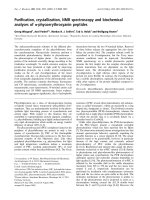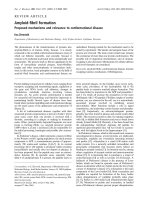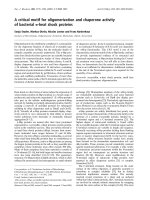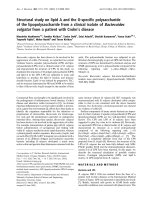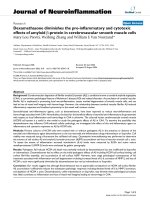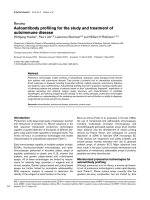Báo cáo y học: " Chronic obstructive pulmonary disease, asthma and protective effects of food intake: from hypothesis to evidence?" docx
Bạn đang xem bản rút gọn của tài liệu. Xem và tải ngay bản đầy đủ của tài liệu tại đây (54.19 KB, 4 trang )
commentary
review reports research article
COPD = chronic obstructive pulmonary disease; FEV
1
= forced expiratory volume in 1 s.
Available online />Introduction
Changes in patterns of dietary consumption, associated
with development of a more affluent lifestyle, may have con-
tributed to the rise in asthma over the past few decades
[1,2]. Plausible mechanisms have been proposed for the
influence of dietary factors such as sodium, magnesium,
antioxidants, selenium and fats on respiratory symptoms
and lung function (summarised in [3]). The number of
observational and experimental studies supporting these
mechanisms has increased rapidly over the past few years
(reviewed in [3–7]). In this commentary, we shall discuss
some issues that need to be addressed in future observa-
tional studies to further explore the evidence for a causal
relation between dietary intake and asthma or COPD.
Current evidence from observational studies
Vitamins C, E and beta-carotene are antioxidant vitamins
and may protect the lungs from oxidative damage by
smoking or air pollution. Vitamin C is a free-radical scav-
enger present in intracellular and extracellular lung fluids.
Vitamin E is present in extracellular lung fluid and lipid
membranes, where it converts oxygen radicals and lipid
peroxyl radicals to less-reactive forms. Beta-carotene
(provitamin A) is a free-radical scavenger present in tissue
membranes.
Observational studies have shown repeatedly that the
intake of vitamin C and of fruits rich in vitamin C is posi-
tively related to lung function. Effect estimates from recent
studies [8–12] fit well within those of studies that were
reviewed earlier [3–5]. The forced expiratory volume in 1 s
(FEV
1
) in subjects with a ‘high’ intake of fruits (once per
week or more) is about 80–100 ml higher than in subjects
with a low intake (less than once per week). A 100 mg
increase in vitamin C intake per day is also associated
with an approximately 10–50 ml increase in FEV
1
[5].
Commentary
Chronic obstructive pulmonary disease, asthma and protective
effects of food intake: from hypothesis to evidence?
Henriëtte A Smit
Department of Chronic Disease Epidemiology, National Institute of Public Health and the Environment, Bilthoven, The Netherlands
Correspondence: Henriëtte A Smit, Department of Chronic Disease Epidemiology, National Institute of Public Health and the Environment, PO Box 1,
3720 BA Bilthoven, The Netherlands. Tel: + 31 30 2743830; fax: +31 30 2744407; e-mail:
Abstract
Evidence for a role of diet in asthma and chronic obstructive pulmonary disease (COPD) has been
accumulating rapidly over the past decade. Associations have been reported between the intake of
fruit, fish, antioxidant vitamins, fatty acids, sodium or magnesium, and indicators of asthma and COPD.
Several issues need to be addressed before causality of these associations can be established. The
role of diet in the development of disease and the induction time and reversibility of the effect needs
further investigation. The role of smoking habits in the relation of diet and respiratory disease also
needs to be elucidated. Nevertheless, based on the available evidence, dietary guidelines could be
proposed for the primary and secondary prevention of asthma and COPD that are in line with existing
dietary guidelines for the prevention of coronary heart disease and cancer.
Keywords: asthma, chronic obstructive pulmonary disease, diet, epidemiology
Received: 23 April 2001
Revisions requested: 17 May 2001
Revisions received: 23 May 2001
Accepted: 13 June 2001
Published: 9 July 2001
Respir Res 2001, 2:261–264
This article may contain supplementary data which can only be found
online at />© 2001 BioMed Central Ltd
(Print ISSN 1465-9921; Online ISSN 1465-993X)
Respiratory Research Vol 2 No 5 Smit
The intake of vitamin C or fruits is less consistently associ-
ated with respiratory symptoms than with lung function.
The evidence for a protective effect of the antioxidant
(pro)vitamins E and beta-carotene on respiratory symp-
toms and lung function has increased over the past few
years [10–14]. The joint effect of the intake of (pro)vita-
mins C, E and beta-carotene was smaller than the sum of
their independent effects [10]. This may be caused by
their presence in the same foods and by the biological
interaction of vitamins C and E [13,15].
A beneficial association between fish intake and asthma
was suggested by the observation that the prevalence of
asthma was low in Eskimo populations, who have a high
fish intake [16]. A beneficial effect was attributed to the
presence of n-3 fatty acids in fish oil, which competitively
inhibits the arachidonic acid metabolism and thus reduces
the production of inflammatory mediators. Although experi-
mental studies showed that supplementation with con-
stituents of fish oil led to increased levels in cell
membranes, no improvement was observed in clinical
manifestation of asthma in patients [7]. A recent system-
atic review of randomised controlled trials in patients with
asthma concluded that there was no convincing evidence
for a protective effect of fish oil supplementation or
increased intake of fish oil in the improvement of asthma
control [17]. A beneficial effect of fish intake on lung func-
tion was reported in several studies in the mid-1990s, but
findings on the association with respiratory symptoms
were conflicting [4,5,18,19]. More recent observational
studies have not confirmed the earlier findings [11,12,20].
Magnesium may play a beneficial role in the prevention and
treatment of asthma through relaxation of the bronchial
smooth muscle [21]. A beneficial effect of magnesium on
lung function, airway reactivity or wheeze was observed in
two observational studies [22,23], but not confirmed in one
other study [11]. Some of the experimental studies in
asthma patients have shown beneficial effects of magne-
sium but, at present, these results are too inconsistent to
draw a firm conclusion. The protective effect of the intake
of flavonoids and whole wheat or bread that was recently
reported also requires further confirmation [12,20,24].
Potential beneficial effects of dietary factors such as sele-
nium, manganese, pyridoxine, copper and zinc have been
suggested but need to be further investigated [4,7].
Besides these potentially protective effects of some
dietary factors, adverse effects on the lungs have been
suggested for other dietary factors. For example, dietary
sodium may increase airway reactivity through potentiation
of the electrogenic sodium pump in the membrane of the
airway smooth muscle [1,25]. A high sodium intake was
shown to increase bronchial hyperresponsiveness in
experimental studies, especially in subjects with asthma
symptoms, but the association with other respiratory end-
points such as medication use and lung function was not
consistent [4,5,7]. There is also no consistent evidence for
a harmful effect of sodium intake on bronchial hyperreac-
tivity or other respiratory endpoints from observational
studies in the general population [1,4,5]. Other dietary
factors that may potentially be harmful are n-6 fatty acids
and trans-fatty acids [6].
There is thus support from experimental and observational
studies for an association of several dietary factors with
indicators of asthma (airway reactivity, IgE, asthma symp-
toms) and COPD (lung function, COPD symptoms),
although the consistency of the evidence is a matter of
judgement (see Table 1). Because of the overlap of indica-
tors of asthma and COPD in adults, it is often not clear
from observational studies whether a specific dietary
factor is associated with clinical asthma or clinical COPD.
There are several other issues that need to be addressed
in future studies before conclusions on causality of the
associations can be drawn.
Random variation or weak association?
The findings across studies are still inconsistent for many
dietary factors, which may lead to the conclusion that they
result from random variation. The observed associations are,
however, often weak and it is well known that small effect
estimates are more susceptible to confounding bias and to
misclassification of dietary intake and disease outcome
[26]. Differences in methods of data collection and analysis
may be another source of variability between studies.
Reporting bias should be considered in reviewing the role of
diet in asthma and COPD, since statistically significant find-
ings tend to be published more frequently or more compre-
hensively than negative findings. True variability across
populations may obviously exist in the association between
diet and respiratory disease. For example, a study in three
countries using the same methods of data collection and
analysis showed that different dietary factors were associ-
ated with lung function in each of the countries [12].
Table 1
Dietary factors and asthma or chronic obstructive pulmonary
disease: summary of the available evidence
Relatively consistent Further evidence
evidence needed
Potentially beneficial Fruits Fish oils/n-3 fatty acids
association Vitamin C Magnesium
Vitamin E Whole wheat
Beta-carotene Flavonoids
Selenium, manganese
Pyridoxine
Copper, zinc
Potentially harmful Sodium n-6 fatty acids
association Trans-fatty acids
commentary
review reports research article
There are thus several possible explanations for the incon-
sistent findings on the relation between diet and respira-
tory disease. A meta-analysis of the original data of some
of the larger observational studies may allow a better
judgement of consistency of the findings.
The role of smoking habits
Confounding by smoking is a major concern in the interpre-
tation of the observed protective effect of diet on respiratory
disease. Smoking has great impact on respiratory disease,
and dietary habits of smokers are less favourable than those
of nonsmokers, even more so in heavy smokers than in light
smokers. Results are therefore often presented for never
smokers, former smokers and current smokers separately.
Residual confounding may still affect the observed associa-
tions in ever smokers, although it has been suggested that
extensive control for smoking intensity and smoking duration
in the statistical analysis is likely to remove most of the
residual confounding by smoking [9,10].
Lungs of smokers are exposed to high levels of oxidants
and other inflammatory agents, which has raised the ques-
tion whether dietary factors are expected to have a similar
or a larger effect in smokers compared with nonsmokers.
Yet, this question remains largely unanswered because
plausible biological mechanisms can be proposed for
either of these effects and results from observational
studies are equivocal in this respect. Some observational
studies reported that associations between dietary intake
and respiratory indicators were restricted to ever smokers
[9,13], whereas other studies observed effects in smokers
that were similar or slightly larger compared with non-
smokers (for recent examples, see [8,10,11,20,27]). One
large population-based study with substantial control for
smoking habits even reported effect modification by
smoking status that was different in direction and magni-
tude for each of the antioxidant vitamins [10]. Although Hu
and Cassano suggested plausible mechanisms to explain
these findings, the variability in effect modification illus-
trates the complexity of the role of smoking in the relation
between dietary intake and respiratory disease.
Nutrients, foods or a healthy diet?
The effects of diet may be due to specific nutrients, to
specific foods or to a ‘healthy diet’. Studying the role of
individual nutrients is relevant to understand the biological
mechanisms behind the observed associations. Con-
versely, information on a protective effect of foods or a
dietary pattern (e.g. a ‘healthy’ diet) is more useful for the
development of dietary guidelines. More information is
also needed on the question whether specific nutrients or
foods have an independent effect on respiratory disease
or whether the net effect of different components is
smaller than the sum of the independent effects, due to
interaction between dietary components. For example, it
was observed that a ‘healthy diet’ consisting of a ‘realistic’
favourable intake of fruits (>180 g/day), whole grains
(> 45 g/day) and moderate alcohol consumption
(1–3 glasses/day) was associated with a 139 ml higher
FEV
1
and a 50% lower prevalence of COPD symptoms
than an unfavourable intake of these foods [20]. The con-
tribution of each of these foods to the overall beneficial
effect was largely additive.
Temporal relationship
Information on the temporal relationship between dietary
intake and asthma or COPD is of critical importance in the
interpretation of causality. Since most of the associations
between diet and respiratory disease originate from cross-
sectional studies, however, there is little information on
whether dietary factors are truly involved in the develop-
ment of asthma or COPD. For the same reason, data on
induction time or reversibility of the potential effect of diet
are scarce.
Induction time
Intervention studies have shown that effects of some
dietary supplements on markers of the disease process
such as airway inflammation, bronchoconstriction or
airway obstruction may have a short induction time (days
or weeks). For example, a short-term protective effect of
antioxidants on lung function was observed in two inter-
vention studies in subjects with a high exposure to oxida-
tive air pollution under natural conditions [28,29].
Subjects who received supplements of antioxidant vita-
mins C, E and beta-carotene suffered a lower loss of lung
function (FEV
1
) at the end of the day than the control
group. Since repeated short-term loss of lung function
may result in more permanent damage, this suggests that
long-term lung function loss may also be prevented in sub-
jects with high exposure to oxidants. Nevertheless, a long-
term intervention study showed no beneficial effect of
6-year supplementation of alpha-tocopherol and beta-
carotene intake on the 5–8-year incidence of COPD
symptoms in smokers [30].
Reversibility
The reversibility of the effect of fruit intake on lung function
has been addressed in two recent longitudinal studies.
Carey et al [27] observed that a change in intake of fresh
fruit over a 7-year period, but not the average intake, was
beneficially associated with a change in lung function over
that period. It was concluded that this supports a
reversible protective effect of fruit intake. However, this
conclusion was not confirmed in another prospective
study showing a cross-sectional beneficial effect but no
longitudinal beneficial effect of the intake of vitamin E and
apples on lung function. The decline in lung function over
a 5-year period was not associated with average intake or
with a change in the intake of vitamin E, C or apples [11].
It is thus not clear from these longitudinal studies whether
the protective effect of diet on lung function is temporal
Available online />and reversible or whether a more permanent reduction in
the age-related decline in lung function exists.
The role of diet in the development of asthma in children
may become clearer in a few years, when more results will
become available from birth cohort studies that are cur-
rently being performed in several countries. More data on
the role of diet in the development and progression of
COPD are likely to become available after follow-up of
several of the reported cross-sectional studies.
Conclusion
Although the interest in the association between diet and
respiratory disease originates from the search for causes
of the rise in asthma, sound data to confirm this hypothe-
sis in retrospect are lacking since our living conditions
have altered in many other ways than dietary habits only.
The available evidence from observational studies sug-
gests a role of diet in asthma and also in COPD, but
causality of the association has not been confirmed.
Looking to the future, studies among populations that
have recently become exposed to a rapidly changing envi-
ronment and a more affluent lifestyle, such as those in
former Eastern Germany [31] or Jeddah, Saudi Arabia
[32], are of particular interest. These studies will allow us
to investigate the effects of diet and other environmental
factors at the individual level while the environmental con-
ditions are changing. Studies in Western countries where
changes have already taken place may contribute to a
better understanding of the protective role of diet in lung
disease, provided they focus on the temporal effects of
diet and on a careful assessment of the role of smoking
and other lifestyle factors. Nevertheless, on the basis of
current knowledge, it seems justified to promote a healthy
diet according to existing guidelines for the prevention of
coronary heart disease and cancer.
References
1. Burney P: A diet rich in sodium may potentiate asthma: epi-
demiological evidence for a new hypothesis. Chest 1987, 91:
143S-148S.
2. Seaton A, Godden DJ, Brown K: Increase in asthma: a more
toxic environment or a more susceptible population? Thorax
1994, 49:171-174.
3. Godden DJ, Devereux GS, Anderson WJ: Environmental lung
disease: the role of diet. Monaldi Arch Chest Dis 1999, 54:479-
484.
4. Fogarty A, Britton J: The role of diet in the aetiology of asthma.
Clin Exp Allergy 2000, 30:615-627.
5. Smit HA, Grievink L, Tabak C: Dietary influences on chronic
obstructive lung disease and asthma: A review of the epi-
demiological evidence. Proc Nutr Soc 1999, 58:309-319.
6. Fogarty A, Britton J: Nutritional issues and asthma. Curr Opin
Pulmon Med 2000, 6:86-89.
7. Monteleone CA, Sherman AR: Nutrition and asthma. Arch Intern
Med 1997, 157:23-34.
8. Hu G, Zhang X, Chen J, Peto R, Campbell TC, Cassano PA:
Dietary vitamin C intake and lung function in rural China. Am J
Epidemiol 1998, 148:594-599.
9. Butland BK, Strachan DP, Anderson HR: Fresh fruit intake and
asthma symptoms in young British adults: confounding or
effect modification by smoking? Eur Respir J 1999, 13:744-
750.
10. Hu G, Cassano PA: Antioxidant nutrients and pulmonary func-
tion: the Third National Health and Nutrition Examination
Survey (NHANES III). Am J Epidemiol 2000, 151:975-981.
11. Butland BK, Fehily AM, Elwood PC: Diet, lung function, and lung
function decline in a cohort of 2512 middle aged men. Thorax
2000, 55:102-108.
12. Tabak C, Smit HA, Räsänen L, Fidanza F, Menotti A, Nissinen A,
Feskens EJM, Heederik D, Kromhout D: Dietary factors and pul-
monary function: a cross-sectional study in middle aged men
from three European countries. Thorax 1999, 54:1021-1026.
13. Bodner C, Godden D, Brown K, Little K, Ross S, Seaton A:
Antioxidant intake and adult-onset wheeze: A case–control
study. Eur Respir J 1999, 13:22-30.
14. Fogarty A, Lewis S, Weiss S, Britton J: Dietary vitamin E, IgE
concentrations, atopy. Lancet 2000, 356:1573-1574.
15. Britton JR, Pavord ID, Richards KA, Knox AJ, Wisniewski AF,
Lewis SA, Tattersfield AE, Weiss ST: Dietary antioxidant vitamin
intake and lung function in the general population. Am J
Respir Crit Care Med 1995, 151:1383-1387.
16. Kromann N, Green A: Epidemiological studies in the Upernavik
District, Greenland. Acta Med Scand 1980, 208:401-406.
17. Woods RK, Thien FCK, Abramson MJ: Dietary marine fatty acids
(fish oil) for asthma. Cochrane Database Syst Rev 2000,
CD001283:1-12.
18. Britton J: Dietary fish oil and airways obstruction. Thorax 1995,
50(suppl 1):S11-S15.
19. Schwartz J: Role of polyunsaturated fatty acids in lung
disease. Am J Clin Nutr 2000, 71(suppl):393S-396S.
20. Tabak C, Smit HA, Heederik D, Ocké MC, Kromhout D: Diet and
chronic obstructive pulmonary disease: independent benefi-
cial effects of fruits, whole grains, and alcohol (the MORGEN
study). Clin Exp Allergy 2001, 31:747-755.
21. Dominguez LJ, Barbagallo M, Di Lorenzo G, Drago A, Scola S,
Morici G, Caruso C: Bronchial reactivity and intracellular mag-
nesium: a possible mechanism for the bronchodilating effects
of magnesium in asthma. Clin Sci 1998, 95:137-142.
22. Britton JR, Pavord ID, Richards KA, Wisniewski AF, Knox AJ,
Lewis SA, Tattersfield AE, Weiss ST: Dietary magnesium, lung
function, wheezing, and airway hyperreactivity in a random
adult population sample. Lancet 1994, 344:357-362.
23. Soutar A, Seaton A, Brown K: Bronchial reactivity and dietary
antioxidants. Thorax 1997, 52:166-170.
24. Tabak C, Arts ICW, Smit HA, Heederik D, Kromhout D: COPD
and intake of catechins, flavonols and flavones: the MORGEN-
study. Am J Respir Crit Care Med 2001, 164:61-64.
25. Knox AJ, Ajao P, Britton JR, Tattersfield A: Effect of sodium-
transport inhibitors on airway smooth muscle contractility in
vitro. Clin Sci 1990, 79:315-323.
26. Rothman KJ, Poole C: A strengthening programme for weak
assocations. Int J Epidemiol 1988, 17:955-959.
27. Carey IM, Strachan DP, Cook DG: Effects of changes in fresh
fruit consumption on ventilatory function in healthy British
adults. Am J Respir Crit Care Med 1998, 158:728-733.
28. Grievink L, Zijlstra A, Ke X, Brunekreef B: Double-blind interven-
tion trial on modulation of ozone effects on pulmonary func-
tion by antioxidant supplements. Am J Epidemiol 1999, 149:
306-314.
29. Romieu I, Meneses F, Ramirez M, Ruiz S, Perez Padilla R, Sienra
JJ, Gerber M, Grievink L, Dekker R, Walda I, Brunekreef B:
Antioxidant supplementation and respiratory functions among
workers exposed to high levels of ozone. Am J Respir Crit
Care Med 1998, 158:226-232.
30. Rautalahti M, Virtamo J, Haukka J, Heinonen OP, Sundvall J,
Albanes D, Huttunen JK: The effect of alpha-tocopherol and
beta-carotene supplementation on COPD symptoms. Am J
Respir Crit Care Med 1997, 156:1447-1452.
31. von Mutius E, Weiland SK, Fritzsch C, Duhme H, Keil U: Increas-
ing prevalence of hay fever and atopy among children in
Leipzig, East Germany. Lancet 1998, 351:862-866.
32. Hijazi N, Abalkhail B, Seaton A: Diet and childhood asthma in a
society in transition: a study in urban and rural Saudi Arabia.
Thorax 2000, 55:775-779.
Respiratory Research Vol 2 No 5 Smit

